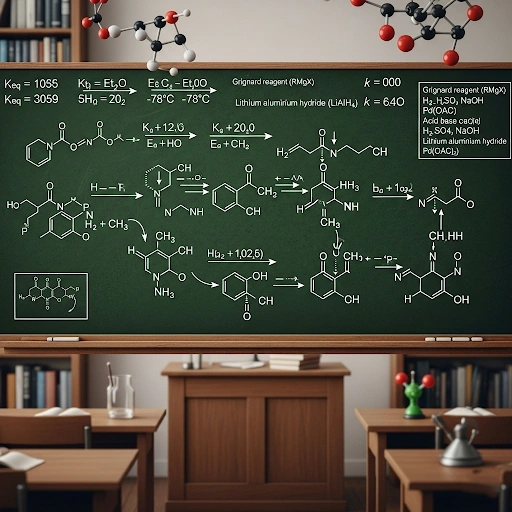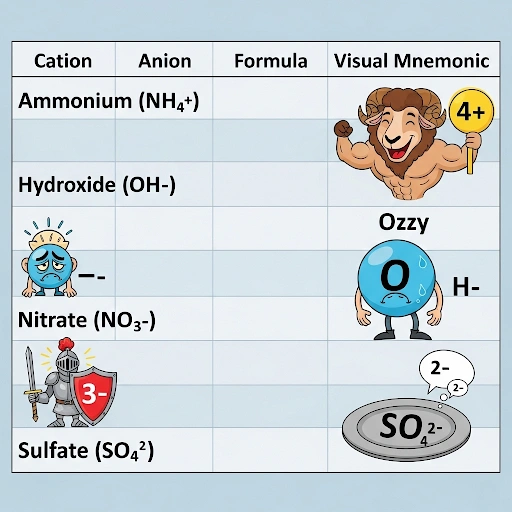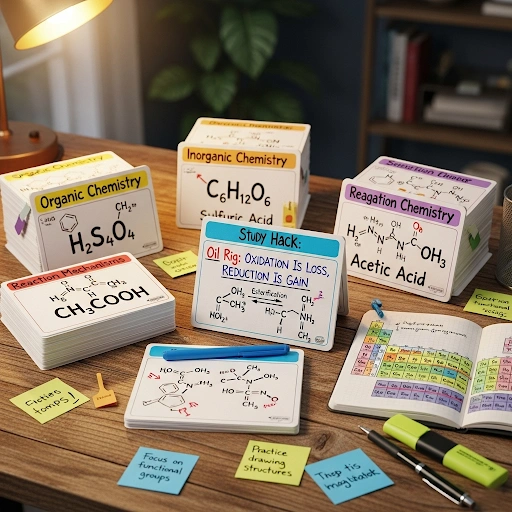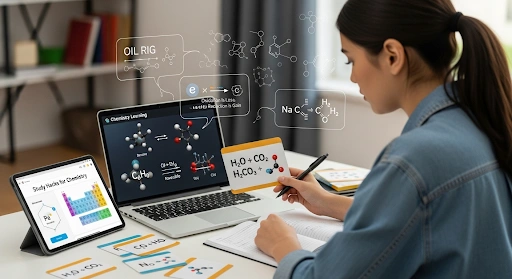Chemistry can feel overwhelming with its endless formulas and reactions, but using study hacks chemistry formulas can make memorization smarter and less stressful. By incorporating study hacks chemistry formulas like active recall and spaced repetition, students can retain complex concepts more effectively. Even practicing regularly with study hacks chemistry formulas turns daunting tasks into manageable learning sessions. Overall, these study hacks for chemistry formulas help you learn easier, strengthen understanding, and excel in your studies.
- Why Memorizing Chemistry Formulas is a Challenge (and Study Hacks Chemistry Formulas That Help)
- Why These Study Hacks Will Help You Learn Chemistry Easier
- How It Works: Practical Study Hacks for Memorizing Chemistry Formulas
- Real-Life Use Case: Mastering Organic Functional Groups
- Comparison: Memorization Techniques for Chemistry
- Common Mistakes to Avoid When Memorizing Chemistry Formulas
- Expert Tips and Best Practices for Chemistry Formula Memorization
- FAQ Section
- Conclusion
Why Memorizing Chemistry Formulas is a Challenge (and Study Hacks Chemistry Formulas That Help)
Chemistry formulas aren’t just random strings of letters and numbers; understanding them requires effective study hacks chemistry formulas to see the relationships and reactions they represent. From simple molecules like H2OH_2O to complex compounds like glucose (C6H12O6C_6H_{12}O_6), using study hacks for chemistry formulas can help make sense of the information. The real challenge is their volume and abstract nature, but applying practical study hacks chemistry formulas makes learning manageable. With consistent study hacks on chemistry formulas, precision and comprehension become much easier.
Why Effective Formula Memorization is Crucial for Chemistry Success in 2025:
- Foundation for Problem-Solving: You can’t balance equations, calculate molar masses, or predict reaction products without knowing the correct formulas for reactants and products. Formulas are the building blocks of chemistry problem-solving.
- Conceptual Understanding: While rote memorization has its limits, truly understanding a formula’s components (e.g., what subscripts and coefficients mean) deepens your conceptual grasp of chemical principles.
- Efficiency in Exams: Knowing formulas cold saves valuable time during tests, allowing you to focus on the more challenging application and analytical questions.
- Prevents Errors: Misremembering a single subscript or charge can lead to entirely incorrect calculations or reaction predictions, impacting your grade.
- Builds Confidence: Consistently recalling formulas boosts your confidence in the subject, reducing test anxiety and making the learning process more enjoyable.
- Gateway to Advanced Topics: Success in introductory chemistry (where many formulas are introduced) is foundational for advanced topics like organic chemistry, biochemistry, and physical chemistry.
The goal isn’t just to parrot formulas but to understand and apply them. Using study hacks chemistry formulas helps you grasp the logic behind each formula, while practical study hacks for chemistry formulas guide how to practice effectively. With consistent study hacks chemistry formulas, you can build a strong foundation without getting stuck on rote memorization. These study hacks for memorizing chemistry formulas act as scaffolding, making complex concepts easier to retain and apply.

Why These Study Hacks Will Help You Learn Chemistry Easier
Traditional rote memorization often falls short when faced with the complexity of chemistry. The following study hacks for memorizing chemistry formulas are designed to tap into how your brain naturally learns, making the process more efficient, effective, and less frustrating. They help you to learn chemistry easier by building deeper connections and improving long-term retention:
- Active Recall: Instead of passively rereading, actively testing yourself forces your brain to retrieve information. This strengthens neural pathways and identifies what you genuinely know versus what you just recognize.
- Spaced Repetition: This technique involves reviewing material at increasing intervals. It leverages the “spacing effect,” where revisiting information just as you’re about to forget it reinforces memory powerfully.
- Conceptual Understanding: When you understand the “why” behind a formula (e.g., why \(H_2O\) and not \(HO\)), memorization becomes less about rote work and more about logical deduction. Formulas become extensions of principles.
- Mnemonics and Associative Learning: Creating memorable phrases, rhymes, or visual associations turns abstract formulas into something concrete and easier to recall. This taps into your creative memory.
- Visual Learning: Drawing diagrams, creating flashcards with visual cues, or mapping out reaction pathways helps visualize relationships that are hard to grasp textually.
- Practical Application: The more you use a formula in practice problems, experiments, or real-world scenarios, the more ingrained it becomes. Application is the ultimate form of reinforcement. For more general advice on learning, check out our insights on effective study methods.
How It Works: Practical Study Hacks for Memorizing Chemistry Formulas
Let’s dive into actionable study hacks chemistry formulas, showing practical ways to remember formulas efficiently. By applying these study hacks for chemistry formulas, you can practice with purpose and reinforce your understanding. Consistent use of study hacks chemistry formulas helps turn memorization into a manageable routine, while these study hacks on chemistry formulas guide you step by step to truly learn chemistry easier.
1. Conceptual Understanding Before Memorization (The “Why”)
Don’t jump straight to memorizing without first using study hacks chemistry formulas to understand the core concepts. Applying study hacks for chemistry formulas helps you see the logic behind each formula. Consistently practicing study hacks on chemistry formulas strengthens long-term retention, while these study hacks chemistry formulas ensure you learn effectively rather than just memorize blindly.
- Grasp the Basics: Before memorizing \(H_2SO_4\), understand what polyatomic ions are, how ionic and covalent bonds form, and how naming conventions work.
- Ask “Why?”: Why is it \(CO_2\) and not \(CO\)? Why do certain elements combine in specific ratios? Understanding valency, electronegativity, and electron configurations makes formulas logical, not arbitrary.
- Draw Structures: For organic chemistry, don’t just memorize the name “methanol.” Draw its structure (\(CH_3OH\)). Visualize the bonds and functional groups.
2. Active Recall (Testing Your Brain)
This approach is scientifically proven to be more effective than passive review, especially when you apply study hacks chemistry formulas. Using study hacks for chemistry formulas helps you actively engage with the material. Incorporating study hacks on chemistry formulas regularly strengthens memory retention, and these study hacks chemistry formulas make understanding complex concepts much easier.
- Flashcards: Write the name of a compound/reaction on one side (\(Sulfuric\,Acid\)), and its formula on the other (\(H_2SO_4\)). For reactions, put reactants on one side, products on the other. Don’t flip until you’ve *actively* tried to recall.
- “Blank Page” Method: After studying a set of formulas, close your notes and try to write down everything you remember about them on a blank piece of paper. Then, compare.
- Quiz Yourself: Use end-of-chapter questions, online quizzes, or ask a study partner to quiz you.
3. Spaced Repetition (Timing is Everything)
Reviewing information at optimal, increasing intervals prevents forgetting, especially when using study hacks chemistry formulas. Applying study hacks for chemistry formulas in a consistent schedule strengthens memory. Incorporating study hacks on chemistry formulas with spaced repetition ensures long-term retention, and these study hacks chemistry formulas make revisiting material more effective and less stressful.
- Use Apps: Digital flashcard apps like Anki or Quizlet automatically schedule your reviews based on spaced repetition algorithms.
- Manual System: If using physical flashcards, sort them into “Know Well,” “Need More Practice,” and “Struggling.” Review “Struggling” cards daily, “Need More Practice” every few days, and “Know Well” weekly.
- Consistent Short Sessions: Instead of one long cramming session, do 15-20 minutes of spaced repetition daily.
4. Mnemonics & Association (Creative Connections)
Turn abstract formulas into memorable stories, images, or phrases by using study hacks chemistry formulas. Creative study hacks for chemistry formulas help link concepts visually, making them easier to recall. Applying study hacks on chemistry formulas with mnemonics or associations reinforces memory, and these study hacks chemistry formulas turn complex information into something manageable and memorable.
- Acronyms/Acrostics:
- For Polyatomic Ions ending in -ate (often have 3 oxygens): “Nick the Baby Camel Ate Clam Supper in Phoenix” \(\rightarrow\) Nitrate \((NO_3^-)\), Bromate \((BrO_3^-)\), Chlorate \((ClO_3^-)\), Sulfate \((SO_4^{2-})\), Phosphate \((PO_4^{3-})\). (The number of consonants often indicates the charge, or you can tailor the mnemonic for charge too).
- Visual Imagery: Imagine the elements interacting. For example, for \(H_2O\), picture two tiny hydrogen atoms hugging a larger oxygen atom.
- Rhymes & Songs: Simple rhymes can make complex sequences stick.
- Method of Loci (Memory Palace): Associate each formula with a specific location in a familiar mental space (e.g., your house). As you walk through the “palace,” each location triggers a formula.

5. Practice Problems (Application is Key)
The best way to solidify memorization is to apply formulas repeatedly, using study hacks chemistry formulas to guide practice. Consistent study hacks on chemistry formulas help reinforce what you’ve learned, while practical study hacks chemistry formulas make application easier and more effective. Integrating different study hacks for chemistry formulas ensures the knowledge sticks and builds a stronger understanding of each concept.
- Solve Exercises: Work through as many practice problems from your textbook or online resources as possible.
- Work Through Derivations: For equations (e.g., Ideal Gas Law \(PV=nRT\)), understand how they are derived. This can help you reconstruct them if you forget a part.
- Balance Equations: Regularly practice balancing chemical equations. This reinforces your knowledge of chemical formulas and their correct coefficients.
6. Teach Someone Else (Ultimate Retention)
Explaining a concept or formula to someone else forces you to organize your thoughts and identify any gaps in your understanding. The “Protégé Effect” is powerful!
- Study Groups: Explain formulas to your peers.
- Explain to a Pet/Imaginary Friend: Seriously, talking through the steps aloud helps solidify knowledge.
- Create a Tutorial: Pretend you’re making a short video tutorial explaining a specific formula.
Real-Life Use Case: Mastering Organic Functional Groups
Let’s illustrate how a student, Maria, successfully applied study hacks chemistry formulas to tackle the challenge of organic functional groups. By using practical study hacks for chemistry formulas, she could visualize and organize complex structures more effectively. Consistent use of study hacks on chemistry formulas helped her retain patterns and relationships between compounds. These study hacks chemistry formulas made learning less overwhelming and allowed her to confidently master a common stumbling block in chemistry.
Maria was struggling to differentiate and memorize the structures and formulas for aldehydes, ketones, carboxylic acids, and esters, so she turned to study hacks chemistry formulas to simplify the process. By applying study hacks for chemistry formulas, she could recognize patterns between different functional groups. Using consistent study hacks on chemistry formulas helped her retain the arrangement of carbon, oxygen, and hydrogen in each compound. These study hacks chemistry formulas made it easier for Maria to internalize complex structures without feeling overwhelmed.
Maria’s Approach:
- Conceptual Understanding First: Instead of just memorizing the formula, Maria first understood the concept of the carbonyl group (\(C=O\)) as the central feature for all these. She learned how the atoms bonded and why each functional group had its unique properties.
- Visual Sketching & Comparison: On a large whiteboard, Maria drew the generalized structure for each functional group side-by-side:
- Aldehyde: \((R-CHO)\) – \(C=O\) with an \(H\) on one side. She imagined an “H” waving hello to the aldehyde.
- Ketone: \((R-CO-R’)\) – \(C=O\) with carbons on both sides. She pictured the ketone “kicking” carbons on both sides.
- Carboxylic Acid: \((R-COOH)\) – \(C=O\) with an \(-OH\) group. She thought of it as a “carb-oxy-lic” acid.
- Ester: \((R-COO-R’)\) – \(C=O\) with an \(-OR’\) group. This one looked like a “carbon-oxygen-oxygen” ester.
She color-coded the carbonyl group in red for all of them.
- Flashcards with Active Recall & Spaced Repetition: Maria created digital flashcards. On the front, she’d put the name (e.g., “Ketone”). On the back, she’d draw its structure and write its general formula. She used a spaced repetition app (like Anki) that showed her the cards she was struggling with more frequently.
- Mnemonic Device: For the order of reactivity, she created a simple phrase based on the first letter of each functional group (e.g., “Always Keep Calm, Esters Rock!”).
- Practice Problems: She then worked through dozens of practice problems, drawing the structures for names, naming structures, and predicting reactions involving these groups. Each time she applied a formula, it reinforced her memory.
- Teaching a Friend: Maria explained these functional groups to her study partner who was also struggling. The act of articulating the differences and drawing them out for someone else solidified her own understanding immensely.
By combining visual learning, mnemonics, active recall, and spaced repetition with practical study hacks chemistry formulas, Maria found the memorization task more manageable. Using study hacks for chemistry formulas, she could connect each concept to a clear visual or mnemonic. Consistent application of study hacks on chemistry formulas strengthened her retention of complex structures. These study hacks chemistry formulas ultimately allowed her to learn chemistry easier and understand the nuances of organic functional groups.
Comparison: Memorization Techniques for Chemistry
Here’s a comparison of common memorization techniques and how they apply to chemistry formulas, helping you choose the best study hacks for memorizing chemistry formulas:
| Technique | How it Works | Application to Chemistry Formulas | Pros & Cons |
|---|---|---|---|
| Rote Memorization | Repeating information verbatim until it sticks. | Repeatedly writing down \(H_2O\) for water, \(NaCl\) for salt. |
|
| Flashcards (Active Recall) | Presenting a cue and forcing recall of the answer. | Front: “Nitrate Ion” | Back: “\(NO_3^-\)”. Front: “Ideal Gas Law” | Back: “\(PV=nRT\)”. |
|
| Spaced Repetition | Reviewing material at increasing intervals based on recall success. | Using Anki to schedule reviews of chemical formulas every few days, then weeks, then months. |
|
| Mnemonics | Creating memorable associations (acronyms, rhymes, visual imagery). | “Leo the lion says Ger” (Lose Electrons Oxidation, Gain Electrons Reduction) for redox. Or visual story for functional groups. |
|
| Conceptual Understanding / Application | Learning the “why” and applying knowledge in problems. | Understanding bonding principles to predict formulas (\(Na_2S\) vs. \(NaS_2\)) or solving stoichiometry problems. |
|
The most effective strategy for memorizing chemistry formulas combines several study hacks chemistry formulas, focusing on conceptual understanding and active application. Using study hacks for chemistry formulas like spaced repetition and mnemonics helps boost recall efficiently. Consistently applying study hacks on chemistry formulas reinforces memory and deepens understanding. These study hacks chemistry formulas create a balanced approach that makes learning chemistry easier and more effective.
Common Mistakes to Avoid When Memorizing Chemistry Formulas
Even with the best intentions, students often stumble when relying on simple study hacks chemistry formulas. Avoiding common mistakes in study hacks for chemistry formulas can make memorization smoother. Applying effective study hacks on chemistry formulas consistently helps you retain information longer. Using a variety of study hacks chemistry formulas ensures you learn chemistry easier and more effectively.
- Cramming: Trying to stuff all formulas into your brain the night before an exam is a recipe for short-term recall and rapid forgetting. Spaced repetition is the antidote.
- Rote Memorization Without Understanding: Simply memorizing the letters and numbers without understanding what they represent (the “why”) makes formulas abstract, harder to recall, and impossible to apply correctly in problem-solving.
- Passive Review: Just rereading notes or looking at a list of formulas. This creates an illusion of knowing. Active recall is essential to truly test your memory.
- Isolated Learning: Memorizing formulas in isolation without connecting them to related concepts (e.g., bonding, reactions, periodicity) makes them harder to retain.
- Not Practicing Application: The brain remembers what it *uses*. If you only memorize formulas but never apply them in solving problems, they won’t stick in long-term memory.
- Ignoring Polyatomic Ions: Many students struggle because they don’t commit common polyatomic ions (e.g., sulfate, nitrate, phosphate) and their charges to memory. These are building blocks for countless compounds.
- Lack of Consistency: Memorization is a continuous process. Sporadic study sessions are far less effective than regular, short bursts of focused practice.
- Over-reliance on One Method: No single hack works for everyone or for every type of formula. A combination of techniques is usually most effective.
Expert Tips and Best Practices for Chemistry Formula Memorization
To truly master memorizing chemistry formulas, start by applying proven study hacks chemistry formulas in your daily routine. Integrating study hacks for chemistry formulas consistently helps strengthen recall and understanding. Using diverse study hacks chemistry formulas allows you to approach formulas from multiple angles. Incorporating these study hacks on chemistry formulas into your regular practice elevates your overall chemistry performance.
- Start Early and Be Consistent: Don’t wait until the night before the exam. Integrate formula memorization into your daily study routine from the beginning of the semester. Consistency beats cramming every time.
- Prioritize Conceptual Understanding: Always strive to understand *why* a formula is structured the way it is. If you understand bonding, valency, and molecular geometry, many formulas become logical, not arbitrary.
- Use Multi-Sensory Learning:
- **See:** Draw formulas, use diagrams, color-code elements.
- **Hear:** Speak formulas aloud, create rhymes or songs.
- **Do:** Write them repeatedly, solve problems, build molecular models.
- Create a “Formula Cheat Sheet” (for study, not exams!): Compile all formulas you need to know onto one or two pages. Review this regularly using active recall. This helps organize the information mentally.
- Focus on Polyatomic Ions: Many complex formulas are built from these common ion groups. Commit their names, formulas, and charges to memory early on.
- Practice Balancing Equations Daily: This forces you to recall and correctly use chemical formulas. It’s a fantastic form of active, applied recall.
- “Formula Friday” or “Daily Drill”: Dedicate a short, consistent time each day or week just for formula recall. Use flashcards or the blank page method.
- Teach a Concept or Formula: The best way to learn is to teach. Explain a formula and its application to a peer, a family member, or even yourself (aloud!).
- Utilize Online Resources: Many websites offer free quizzes, interactive tools, and detailed explanations for chemistry formulas. Look for resources from reputable universities or educational platforms.
- Break Down Complexity: For very long or complex formulas (e.g., biochemical ones), break them into smaller, more manageable chunks. Identify recurring patterns or functional groups.

FAQ Section
Here are some frequently asked questions about study hacks chemistry formulas and how to apply them effectively. Students often wonder which study hacks for chemistry formulas work best for long-term retention. These study hacks on chemistry formulas can make learning and recalling formulas easier and more efficient. Exploring different study hacks chemistry formulas helps you find strategies that fit your learning style.
Q: Is it better to memorize or understand chemistry formulas?
A: Ideally, both! **Understanding** the underlying principles (bonding, periodicity, reaction types) makes memorization much easier and allows for application. **Memorization** of common formulas then becomes faster and frees up cognitive load for complex problem-solving during exams. One without the other is incomplete.
Q: What are some good mnemonics for the periodic table?
A: While not formulas, periodic table mnemonics are popular. For example, “Happy Henry Likes Beer But Could Not Obtain Food” (H, He, Li, Be, B, C, N, O, F) for the first few elements. Creating your own often works best!
Q: How do I memorize balancing chemical equations?
A: Balancing isn’t about memorizing *specific* balanced equations, but memorizing the *process* and common formulas. Practice is key. Start with simple equations, use the “atom count” method, and understand polyatomic ions. The more you practice, the more familiar the formulas become.
Q: Should I write out formulas or use digital tools?
A: Both have benefits. Writing helps kinesthetic learners and reinforces muscle memory. Digital tools (like Anki) excel at spaced repetition and organization. A hybrid approach, where you write and then transfer to digital flashcards for long-term spaced review, can be very effective.
Q: I’m struggling with organic chemistry formulas. Any specific tips?
A: For organic chemistry, focus heavily on **visualizing structures** and **understanding functional groups**. Don’t just memorize names; draw the carbon chains and how the functional groups attach. Create a “functional group cheat sheet” with structures and common reactions. Mnemonics for prefixes (meth-, eth-, prop-) are also helpful.
Q: How can I remember which elements have which charges?
A: For common elements, the periodic table is your best friend. Group 1 elements typically have +1, Group 2 have +2, Group 17 (halogens) have -1. For transition metals, you’ll often need to memorize common charges or deduce them from the compound. Understanding electron configuration and octet rule helps clarify *why* they have those charges.
Q: What’s the best way to review for a chemistry exam that’s heavy on formulas?
A: Prioritize active recall with flashcards for all key formulas. Do a “blank sheet” dump of all formulas you can remember. Then, immediately dive into solving a wide range of practice problems. Pay close attention to unit conversions and balancing equations. Don’t forget to revisit any formulas you consistently miss!
Conclusion
Memorizing complex chemistry formulas doesn’t have to feel overwhelming. By applying effective study hacks chemistry formulas, you can turn a daunting task into a manageable routine. Using smart study hacks for chemistry formulas helps you move past rote memorization and adopt strategies that actually make learning easier. Incorporating different study hacks chemistry formulas, like active recall, spaced repetition, and mnemonics, allows you to retain information longer and understand the concepts behind each formula. These practical study hacks for chemistry formulas not only strengthen memory but also enhance your overall comprehension, making it possible to truly learn chemistry with confidence.
Remember, consistent effort and smart study strategies are your most powerful tools. Embrace these hacks, practice regularly, and watch your confidence in chemistry soar. For more in-depth scientific resources and information, consider exploring the official website of the American Chemical Society (ACS), a leading authority in the field. Happy studying!
To continue your journey into cloud security, consider the in-depth resources from the Cloud Security Alliance (CSA), a leading authority on cloud best practices. For more hands-on guides, check out our other posts on building a secure digital toolkit.
